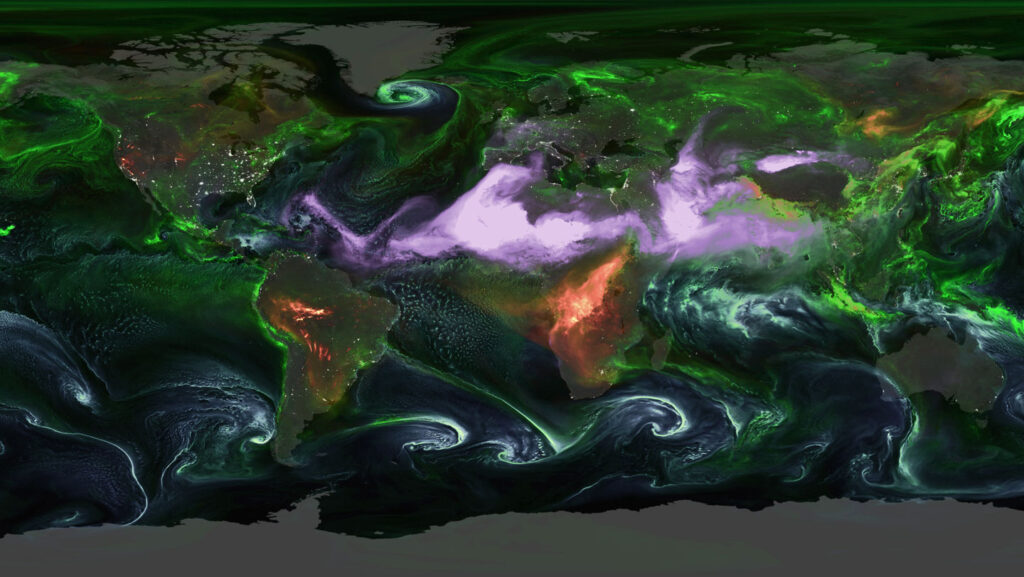
Aerosols, the tiny solid or liquid particles suspended in the atmosphere, play a significant role in Earth’s climate and weather systems. These particles, which can be natural like volcanic ash or artificial such as smoke from burning fossil fuels, are crucial yet often overlooked components of our environmental landscape.
The study of aerosols has gained momentum as scientists seek to understand their impact on climate change and weather phenomena. Through satellite imagery and advanced computer simulations, researchers have been able to track the movement of aerosols across the globe, revealing their complex interactions with atmospheric conditions.
Understanding Aerosols and Their Sources
Aerosols originate from a variety of sources. Natural aerosols include sea salt from ocean spray, dust from deserts, and ash from volcanic eruptions. Human activities contribute significantly to aerosol levels, primarily through the burning of fossil fuels, which releases black carbon and sulfate particles into the atmosphere.
These particles can remain airborne for days or even weeks, traveling vast distances across oceans and continents. For instance, dust from the Sahara Desert can be transported by trade winds across the Atlantic Ocean, affecting air quality and weather patterns in the Americas.
The Role of Aerosols in Climate
Aerosols influence the climate in several ways. They can directly affect the Earth’s energy balance by scattering and absorbing sunlight. Reflective aerosols, such as sulfates, tend to cool the atmosphere by reflecting solar radiation back into space. Conversely, black carbon absorbs sunlight, leading to atmospheric warming.
Moreover, aerosols serve as nuclei for cloud formation, impacting cloud properties and precipitation patterns. This process, known as cloud condensation, can either enhance or suppress rainfall depending on the type and concentration of aerosols present.
Implications for Weather and Climate Change
The presence of aerosols in the atmosphere has significant implications for weather forecasting and climate change models. By affecting cloud formation and precipitation, aerosols can alter weather patterns, leading to more intense storms or prolonged droughts. For example, increased aerosol concentrations have been linked to stronger hurricanes in the Atlantic.
Furthermore, aerosols play a crucial role in the Earth’s radiation budget, which is a critical factor in climate change. As aerosols interact with greenhouse gases, they can either amplify or mitigate the effects of global warming. Understanding these interactions is essential for accurate climate predictions and developing effective mitigation strategies.
Expert Insights and Future Research
According to Dr. Jane Smith, a leading atmospheric scientist, “Aerosols are a double-edged sword in climate science. While they can cool the planet by reflecting sunlight, they also contribute to warming by absorbing heat and altering cloud dynamics.”
“The challenge lies in accurately quantifying their effects and incorporating them into climate models,” Dr. Smith added.
Ongoing research aims to improve our understanding of aerosol dynamics and their interactions with other atmospheric components. NASA and other research organizations are utilizing advanced satellite technology to monitor aerosol distribution and composition, providing valuable data for climate scientists worldwide.
Looking Ahead: The Path Forward
As the scientific community continues to unravel the complexities of aerosols, there is a growing emphasis on reducing human-induced aerosol emissions. Transitioning to cleaner energy sources and implementing stricter air quality regulations are critical steps in mitigating the adverse effects of aerosols on climate and health.
Meanwhile, public awareness and education about aerosols and their environmental impact are essential for fostering a more informed and proactive approach to climate change.
The journey to fully understanding aerosols is ongoing, but with continued research and collaboration, we can hope to develop more effective strategies for managing their impact on our planet.






